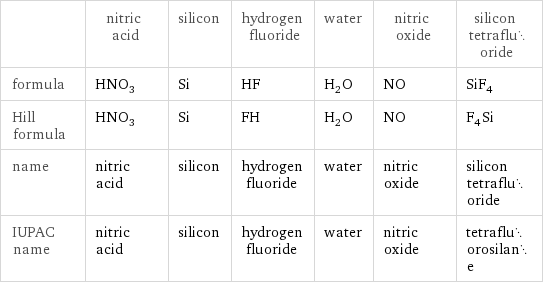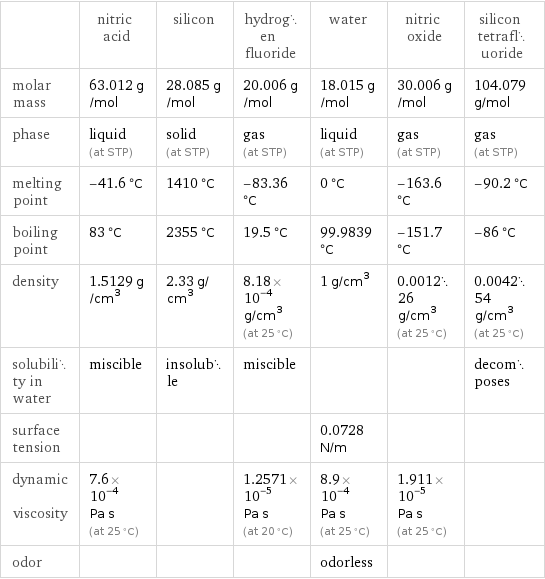Input interpretation

HNO_3 nitric acid + Si silicon + HF hydrogen fluoride ⟶ H_2O water + NO nitric oxide + SiF_4 silicon tetrafluoride
Balanced equation

Balance the chemical equation algebraically: HNO_3 + Si + HF ⟶ H_2O + NO + SiF_4 Add stoichiometric coefficients, c_i, to the reactants and products: c_1 HNO_3 + c_2 Si + c_3 HF ⟶ c_4 H_2O + c_5 NO + c_6 SiF_4 Set the number of atoms in the reactants equal to the number of atoms in the products for H, N, O, Si and F: H: | c_1 + c_3 = 2 c_4 N: | c_1 = c_5 O: | 3 c_1 = c_4 + c_5 Si: | c_2 = c_6 F: | c_3 = 4 c_6 Since the coefficients are relative quantities and underdetermined, choose a coefficient to set arbitrarily. To keep the coefficients small, the arbitrary value is ordinarily one. For instance, set c_2 = 1 and solve the system of equations for the remaining coefficients: c_1 = 4/3 c_2 = 1 c_3 = 4 c_4 = 8/3 c_5 = 4/3 c_6 = 1 Multiply by the least common denominator, 3, to eliminate fractional coefficients: c_1 = 4 c_2 = 3 c_3 = 12 c_4 = 8 c_5 = 4 c_6 = 3 Substitute the coefficients into the chemical reaction to obtain the balanced equation: Answer: | | 4 HNO_3 + 3 Si + 12 HF ⟶ 8 H_2O + 4 NO + 3 SiF_4
Structures

+ + ⟶ + +
Names

nitric acid + silicon + hydrogen fluoride ⟶ water + nitric oxide + silicon tetrafluoride
Equilibrium constant
![Construct the equilibrium constant, K, expression for: HNO_3 + Si + HF ⟶ H_2O + NO + SiF_4 Plan: • Balance the chemical equation. • Determine the stoichiometric numbers. • Assemble the activity expression for each chemical species. • Use the activity expressions to build the equilibrium constant expression. Write the balanced chemical equation: 4 HNO_3 + 3 Si + 12 HF ⟶ 8 H_2O + 4 NO + 3 SiF_4 Assign stoichiometric numbers, ν_i, using the stoichiometric coefficients, c_i, from the balanced chemical equation in the following manner: ν_i = -c_i for reactants and ν_i = c_i for products: chemical species | c_i | ν_i HNO_3 | 4 | -4 Si | 3 | -3 HF | 12 | -12 H_2O | 8 | 8 NO | 4 | 4 SiF_4 | 3 | 3 Assemble the activity expressions accounting for the state of matter and ν_i: chemical species | c_i | ν_i | activity expression HNO_3 | 4 | -4 | ([HNO3])^(-4) Si | 3 | -3 | ([Si])^(-3) HF | 12 | -12 | ([HF])^(-12) H_2O | 8 | 8 | ([H2O])^8 NO | 4 | 4 | ([NO])^4 SiF_4 | 3 | 3 | ([SiF4])^3 The equilibrium constant symbol in the concentration basis is: K_c Mulitply the activity expressions to arrive at the K_c expression: Answer: | | K_c = ([HNO3])^(-4) ([Si])^(-3) ([HF])^(-12) ([H2O])^8 ([NO])^4 ([SiF4])^3 = (([H2O])^8 ([NO])^4 ([SiF4])^3)/(([HNO3])^4 ([Si])^3 ([HF])^12)](../image_source/53207b80e459f3dfa707f93d85f85588.png)
Construct the equilibrium constant, K, expression for: HNO_3 + Si + HF ⟶ H_2O + NO + SiF_4 Plan: • Balance the chemical equation. • Determine the stoichiometric numbers. • Assemble the activity expression for each chemical species. • Use the activity expressions to build the equilibrium constant expression. Write the balanced chemical equation: 4 HNO_3 + 3 Si + 12 HF ⟶ 8 H_2O + 4 NO + 3 SiF_4 Assign stoichiometric numbers, ν_i, using the stoichiometric coefficients, c_i, from the balanced chemical equation in the following manner: ν_i = -c_i for reactants and ν_i = c_i for products: chemical species | c_i | ν_i HNO_3 | 4 | -4 Si | 3 | -3 HF | 12 | -12 H_2O | 8 | 8 NO | 4 | 4 SiF_4 | 3 | 3 Assemble the activity expressions accounting for the state of matter and ν_i: chemical species | c_i | ν_i | activity expression HNO_3 | 4 | -4 | ([HNO3])^(-4) Si | 3 | -3 | ([Si])^(-3) HF | 12 | -12 | ([HF])^(-12) H_2O | 8 | 8 | ([H2O])^8 NO | 4 | 4 | ([NO])^4 SiF_4 | 3 | 3 | ([SiF4])^3 The equilibrium constant symbol in the concentration basis is: K_c Mulitply the activity expressions to arrive at the K_c expression: Answer: | | K_c = ([HNO3])^(-4) ([Si])^(-3) ([HF])^(-12) ([H2O])^8 ([NO])^4 ([SiF4])^3 = (([H2O])^8 ([NO])^4 ([SiF4])^3)/(([HNO3])^4 ([Si])^3 ([HF])^12)
Rate of reaction
![Construct the rate of reaction expression for: HNO_3 + Si + HF ⟶ H_2O + NO + SiF_4 Plan: • Balance the chemical equation. • Determine the stoichiometric numbers. • Assemble the rate term for each chemical species. • Write the rate of reaction expression. Write the balanced chemical equation: 4 HNO_3 + 3 Si + 12 HF ⟶ 8 H_2O + 4 NO + 3 SiF_4 Assign stoichiometric numbers, ν_i, using the stoichiometric coefficients, c_i, from the balanced chemical equation in the following manner: ν_i = -c_i for reactants and ν_i = c_i for products: chemical species | c_i | ν_i HNO_3 | 4 | -4 Si | 3 | -3 HF | 12 | -12 H_2O | 8 | 8 NO | 4 | 4 SiF_4 | 3 | 3 The rate term for each chemical species, B_i, is 1/ν_i(Δ[B_i])/(Δt) where [B_i] is the amount concentration and t is time: chemical species | c_i | ν_i | rate term HNO_3 | 4 | -4 | -1/4 (Δ[HNO3])/(Δt) Si | 3 | -3 | -1/3 (Δ[Si])/(Δt) HF | 12 | -12 | -1/12 (Δ[HF])/(Δt) H_2O | 8 | 8 | 1/8 (Δ[H2O])/(Δt) NO | 4 | 4 | 1/4 (Δ[NO])/(Δt) SiF_4 | 3 | 3 | 1/3 (Δ[SiF4])/(Δt) (for infinitesimal rate of change, replace Δ with d) Set the rate terms equal to each other to arrive at the rate expression: Answer: | | rate = -1/4 (Δ[HNO3])/(Δt) = -1/3 (Δ[Si])/(Δt) = -1/12 (Δ[HF])/(Δt) = 1/8 (Δ[H2O])/(Δt) = 1/4 (Δ[NO])/(Δt) = 1/3 (Δ[SiF4])/(Δt) (assuming constant volume and no accumulation of intermediates or side products)](../image_source/d64c9076f6bde937231d837387f43fa2.png)
Construct the rate of reaction expression for: HNO_3 + Si + HF ⟶ H_2O + NO + SiF_4 Plan: • Balance the chemical equation. • Determine the stoichiometric numbers. • Assemble the rate term for each chemical species. • Write the rate of reaction expression. Write the balanced chemical equation: 4 HNO_3 + 3 Si + 12 HF ⟶ 8 H_2O + 4 NO + 3 SiF_4 Assign stoichiometric numbers, ν_i, using the stoichiometric coefficients, c_i, from the balanced chemical equation in the following manner: ν_i = -c_i for reactants and ν_i = c_i for products: chemical species | c_i | ν_i HNO_3 | 4 | -4 Si | 3 | -3 HF | 12 | -12 H_2O | 8 | 8 NO | 4 | 4 SiF_4 | 3 | 3 The rate term for each chemical species, B_i, is 1/ν_i(Δ[B_i])/(Δt) where [B_i] is the amount concentration and t is time: chemical species | c_i | ν_i | rate term HNO_3 | 4 | -4 | -1/4 (Δ[HNO3])/(Δt) Si | 3 | -3 | -1/3 (Δ[Si])/(Δt) HF | 12 | -12 | -1/12 (Δ[HF])/(Δt) H_2O | 8 | 8 | 1/8 (Δ[H2O])/(Δt) NO | 4 | 4 | 1/4 (Δ[NO])/(Δt) SiF_4 | 3 | 3 | 1/3 (Δ[SiF4])/(Δt) (for infinitesimal rate of change, replace Δ with d) Set the rate terms equal to each other to arrive at the rate expression: Answer: | | rate = -1/4 (Δ[HNO3])/(Δt) = -1/3 (Δ[Si])/(Δt) = -1/12 (Δ[HF])/(Δt) = 1/8 (Δ[H2O])/(Δt) = 1/4 (Δ[NO])/(Δt) = 1/3 (Δ[SiF4])/(Δt) (assuming constant volume and no accumulation of intermediates or side products)
Chemical names and formulas

| nitric acid | silicon | hydrogen fluoride | water | nitric oxide | silicon tetrafluoride formula | HNO_3 | Si | HF | H_2O | NO | SiF_4 Hill formula | HNO_3 | Si | FH | H_2O | NO | F_4Si name | nitric acid | silicon | hydrogen fluoride | water | nitric oxide | silicon tetrafluoride IUPAC name | nitric acid | silicon | hydrogen fluoride | water | nitric oxide | tetrafluorosilane
Substance properties

| nitric acid | silicon | hydrogen fluoride | water | nitric oxide | silicon tetrafluoride molar mass | 63.012 g/mol | 28.085 g/mol | 20.006 g/mol | 18.015 g/mol | 30.006 g/mol | 104.079 g/mol phase | liquid (at STP) | solid (at STP) | gas (at STP) | liquid (at STP) | gas (at STP) | gas (at STP) melting point | -41.6 °C | 1410 °C | -83.36 °C | 0 °C | -163.6 °C | -90.2 °C boiling point | 83 °C | 2355 °C | 19.5 °C | 99.9839 °C | -151.7 °C | -86 °C density | 1.5129 g/cm^3 | 2.33 g/cm^3 | 8.18×10^-4 g/cm^3 (at 25 °C) | 1 g/cm^3 | 0.001226 g/cm^3 (at 25 °C) | 0.004254 g/cm^3 (at 25 °C) solubility in water | miscible | insoluble | miscible | | | decomposes surface tension | | | | 0.0728 N/m | | dynamic viscosity | 7.6×10^-4 Pa s (at 25 °C) | | 1.2571×10^-5 Pa s (at 20 °C) | 8.9×10^-4 Pa s (at 25 °C) | 1.911×10^-5 Pa s (at 25 °C) | odor | | | | odorless | |
Units
